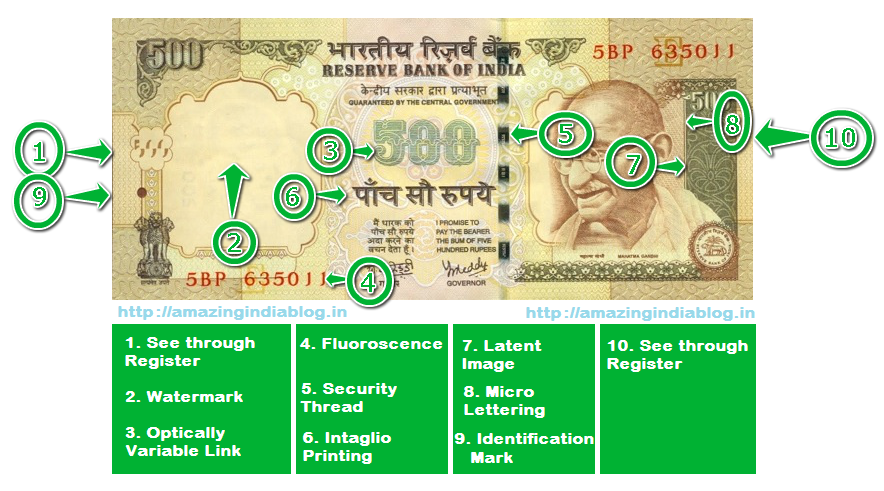You might come across a lot of currency notes on a daily basis, may it be Rs.100, Rs.500 or Rs.1000. Have you ever wondered the note you are carrying is Fake or Original ? Due to the circulation of a lot of fake currency in India, we have come up with this article to guide you how to identify fake currency notes in India. Due to a lot of fake currency rackets being busted in India every year, there is necessity to know the difference between fake and original currency note in India. These days there have been a lot of cases of fake currency notes coming out of ATM Machines as well.
Sometimes, when you go for shopping you might have come across shopkeepers who check the currency notes in light. Have you wondered why ? This article will give you the answers for all your questions related to fake currency identification procedure.
How to Identify Fake Currency Notes in India ?
In this article, we will have taken a Rs.500 note for Specimen and marked various identification marks on it. Do check out each of these identification mark to get a better idea about fake currency identification.
1. See through Register
The small floral design called ‘See through Register’ is printed both on the front (hollow) and back (filled up) of the note in the middle of the vertical band besides the Watermark has an accurate back to back registration. The design appears to be one floral design when seen against the light.
2. Watermark
The Mahatma Gandhi Series of bank notes have the Mahatma Gandhi watermark with a light and shade effect and multi-directional lines in the watermark window. You can see this Watermark by tilting the note against the light.
3. Optically Variable Ink
This is altogether a new security feature which is used in the Rs.1000 and Rs.500 notes with revised colour scheme introduced in November 2000. The numbers 1000 and 500 on the obverse of Rs.1000 and Rs.500 notes respectively is printed in optically variable ink viz., a colour-shifting ink. The colour of the numbers 1000/500 appears green when the note is held flat but it will change to blue when the note is tilted at an angle.
4. Fluorescence
Number panels of the currency notes are printed in fluorescent ink. The notes also have optical fibres. Both are visible when the notes are exposed to ultra-violet lamp.
5. Security Thread
Rs. 1000 notes consists of a readable, windowed security thread alternately visible on the obverse with the inscriptions ‘Bharat’ (in Hindi), ‘1000’ and ‘RBI’, but completely embedded on the reverse. The Rs.500 and Rs.100 currency notes also have a security thread with similar visible features and inscription ‘Bharat’ (in Hindi), and ‘RBI’. When you hold against the light, the security thread on Rs.1000, Rs.500 and Rs.100 is visible as one continuous line.
The Rs.5, Rs.10, Rs.20 and Rs.50 notes contain a readable, completely embedded windowed security thread with the inscription ‘Bharat’ (in Hindi), and ‘RBI’. The security thread can be seen to the left of the Mahatma’s portrait.
6. Intaglio Printing
The portrait of Mahatma Gandhi, the Reserve Bank seal, guarantee and promise clause, Ashoka Pillar Emblem on the left, RBI Governor’s signature are printed by intaglio printing that is in raised prints, this type of printing can be felt by touch, in Rs.20, Rs.50, Rs.100, Rs.500 and Rs.1000 notes.
7. Latent Image
On the obverse side of Rs.1000, Rs.500, Rs.100, Rs.50 and Rs.20 notes, a vertical band on the right side of the Mahatma Gandhi’s portrait contains a latent image showing the respective value in numeral. The latent image is visible only when the note is held horizontally at eye level.
8. Microlettering
This feature is visible between the vertical band and Mahatma Gandhi portrait. It contains the word ‘RBI’. This feature appears well under a magnifying glass.
9. Identification Mark
A unique feature in intaglio has been introduced on the left of the watermark window on all notes except Rs.10/- note, for the visually impaired for identification of the denomination. This feature can be found in different shapes for various denominations (Rs. 20-Vertical Rectangle, Rs.50-Square, Rs.100-Triangle, Rs.500-Circle, Rs.1000-Diamond).
10. See through Register
The small floral design called ‘See through Register’ is printed both on the front (hollow) and back (filled up) of the note in the middle of the vertical band besides the Watermark has an accurate back to back registration. The design appears to be one floral design when seen against the light.
Important Note by RBI :
You must read this note by RBI, which alerts the citizens of India about the legal provisions of counterfeiting. “Printing and circulation of forged notes are offences under Sections 489A to 489E of the Indian Penal Code and are punishable in the courts of law by fine or imprisonment or both.”
So, next time you get an indian currency note from anyone make sure you check its authenticity before accepting it. Hope you liked to know about the procedure to recognize or identify fake Indian currency.
You may also like to Read :
 Amazing India Blog Know India Better
Amazing India Blog Know India Better





